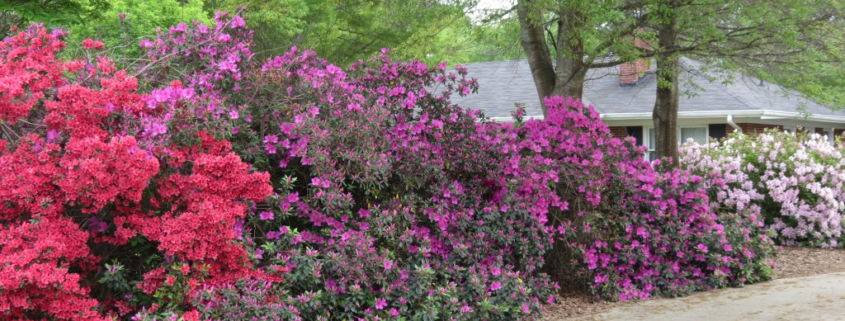Things to Do in the Garden in April
From Trellis Blog – Apr 8, 2020 |
WOODY ORNAMENTALS
- Plant container-grown trees and shrubs
- Last chance to plant balled-and-burlapped trees and shrubs (may no longer be available in your area)
- Fertilize actively growing trees, shrubs, and ground covers
- Prune conifers that are in the candle stage, broadleaf evergreens, and overgrown shrubs
- Prune out any storm damage or dead limbs
- Prune spring-blooming shrubs, like forsythia and azaleas, after they finish blooming
- Mulch planting beds for weed control and moisture conservation
- Control emerged weeds by hand or with herbicides (follow label directions)
- Scout for diseases on trees and shrubs (azalea leaf gall, azalea petal blight, dogwood anthracnose (sometimes seen in the north part of the state), fireblight, cedar apple rust, powdery mildew, entomosporium leaf spot, black spot on roses, botrytis), but be sure to get a diagnosis and Extension recommendation before attempting to treat
- Scout for insects on trees and shrubs (aphids, fall webworm, bagworms, dogwood borers, Eastern tent caterpillar, lace bugs, leaf miners, mealy bugs, thrips, and scales)
HERBACEOUS PLANTS
- Plant summer-flowering bulbs, such as dahlias and gladiolus
- Plant summer annuals according to your frost-free date (click here if you need to check)
- Fertilize actively growing perennials and annuals
- Consider replacing cool-season annuals late this month
- Plant perennials
- Plant annual herbs
- Sow warm-season annual seeds in garden beds
- Deadhead any spent flower blossoms
- Scout for insects and diseases
- Hand-weed for weed control
- Mulch planting beds for weed control and moisture conservation
- Fight the urge to cut back daffodil and any other spring-blooming bulb foliage (allow it to die naturally)
VEGETABLE GARDENS
- Harvest cool-season spring crops (lettuce, chard, broccoli, peas)
- Prepare soil for planting
- Sow warm-season vegetable seeds (beans, squash, corn)
- Plant warm-season transplants (tomatoes, peppers, eggplants)
- Water transplants and seedlings, as needed
- Hand-weed and cultivate as needed for weed control; click here for other options
- Mulch planting beds for weed control and moisture conservation
TURF
- Warm season turf grasses
- Establishment of new turf, in the southern part of the state
- Fertilization begins, based on soil test results, when soil temperatures at the 4-inch depth are consistently 65F and rising
- Core aeration, in the southern part of the state
- Begin planning for any renovation efforts
- Scout for weeds. Since spring green-up is when warm-season grasses are most susceptible to herbicide injury, the mower can serve as a weed control option. If possible, mow regularly.
- Scout for fungal diseases on turf (brown patch, dollar spot). A single fungicide application can protect the grass for four weeks. It is still early spring and a second fungicide application will likely be warranted.
- Cool season turf grass
- Fertilize cool-season grasses, like tall fescue and bentgrass, and grow as many roots as possible to prepare the grass for the upcoming summer heat stress.
- Mid-month, post-emergent weed control for summer broadleaf weeds
- Scout for fungal diseases on turf (brown patch, dollar spot, pythium blight, melting out)
- Scout for insects (cutworms)
Warm-season grasses are beginning to transition into active growth. All the rainfall this winter has resulted in wet soils which are generally slower to warm as water is a buffer of heat.
About sdorn – Sheri is the State Coordinator for the Georgia Master Gardener Extension Volunteer Program and Extension Specialist for Consumer Ornamentals. When she is not traveling about the state of Georgia admiring the work of Georgia Master Gardener Extension Volunteers, she spends time in her own (real and virtual) gardens. Many thanks to Extension Specialists Bodie Pennisi, Clint Waltz, Elizabeth Little, Lisa Ames, and Bob Westerfield for contributing to this post!




